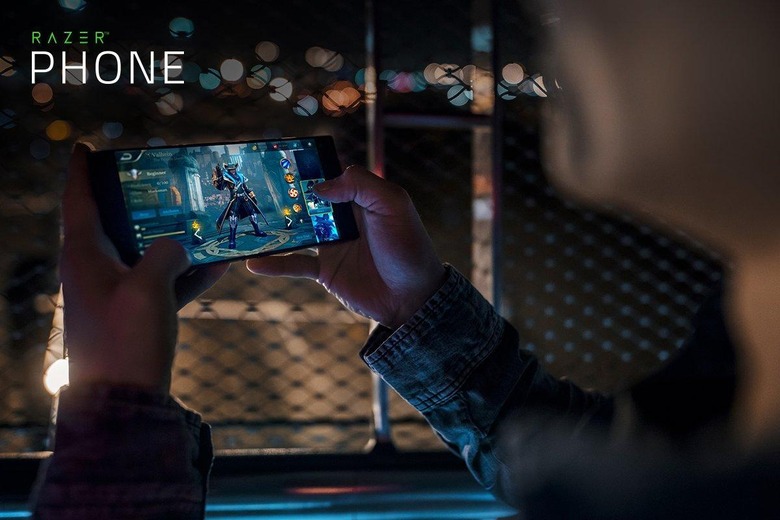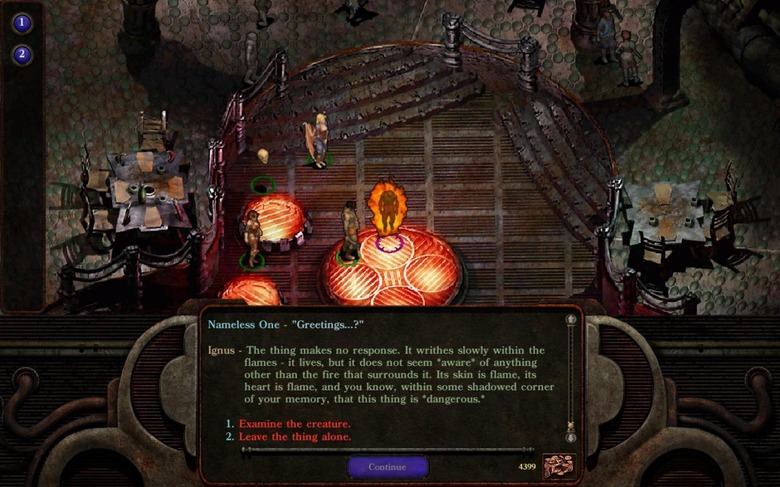Razer has just unveiled its much anticipated first smartphone, a device it bills to be made by gamers for gamers. While the street creds of the Razer Phone, as far as specs go, is undoubtedly the smartphone equivalent of a top-tier gaming PC, at the end of the day, it is pretty much just that: a top-tier smartphone. Its mere existence necessarily raises the question of what a gaming smartphone really is. But perhaps the deeper question that needs to be asked is whether it is what Android gamers and Android gaming needs today. Sadly, it really isn't and Android gaming needs more than just a self-proclaimed "for gamers" smartphone in order to thrive.
Not newer hardware, sort of
Don't get me wrong, the Razer Phone is a beast. Save for, perhaps, the absence of an NVIDIA Tegra processor, it has the hardware any mobile gamer would want. A smooth 120 Hz 2K screen, a generous serving of 8 GB of RAM, Dolby Atmos front-facing stereo speakers, a 4,000 mAh battery, and the latest Snapdragon 835. The thing is, we've seen those specs before. Except for the screen, of course.

We've come to a point in the mobile industry where hardware is actually the only constant. Not that it doesn't change but that you can pretty much expect the next evolution of hardware. Smartphones are only going to get more powerful, memory will get bigger, so on and so forth. Hardware, isn't exactly a problem at this point.
And neither are form factors. Android gaming isn't exactly restricted to smartphones and can actually be found on any device that runs Android, from the powerhouse that is the NVIDIA SHIELD to DIY consoles running Android emulators. And who can forget the short-lived ARCHOS GamePad tablets? We've all seen them before, and very few of them had any staying power.

Not new game engines
If it's not the hardware, then it must be the software, right? Not exactly. Of course, the Android platform itself will always be a factor to consider, but OS considerations haven't always been a huge hurdle either. You might think about the dreaded Android fragmentation, but that is largely mitigated by game engines that take care of compatibility problems as much as they can.
And there are a plethora of game engines for Android. There are the big boys line Unreal Engine 4 and Unity. There are powerful open source options like libgdx or the beginner-friendly AndEngine. And, of course, there's always going to be room for more.

But game engines are really just the tools you need to build and run games. They do not themselves make a game. There is no shortage of tools to make games on Android, even more sophisticated and graphically-intensive ones. Especially as smartphone hardware becomes even more powerful. But Android gaming needs a lot more than just tools.
Not more controllers
It definitely doesn't need more controllers though. There are dozens, if not hundreds, of those already. There might actually be too many that it dilutes the market.
Sure, a gamepad like the Moto GamePad Mod would be nice, removing the need to rely on sometimes unreliable Bluetooth connections. A Nintendo Switch form-factor would also be dreamy, covering multiple gaming settings and needs.

Most Android gaming, however, still happens on the phone, at odd times and places. During those times, when the gaming muse possesses you, you really don't want to be fumbling around to attach or pair a controller. Touch is still the best way to play an Android game, and, frankly, there doesn't seem to be any innovation in that space.
Better controller support
So what does Android gaming need? It might seem contrary to what was said above, but Android actually needs better controller support. There's a fine line that divides having more controllers and having better support for those controllers. While there are legion of game controllers out there, support for them is consistent at best, terrible at worse.
Unified Android support for game controllers was basically an afterthought, which is, to some extent, understandable since it wasn't exactly a priority. Android, after all, is a smartphone platform first and foremost and only a gaming platform by extension. By the time it rolled out, however, game developers have each developed their own ways to support game controllers if the engines they used didn't. This lead to a situation where some Android games played nice with controllers, some didn't, and some lay somewhere in between. It's mostly a trial and error discovery for users, since developers don't usually advertise game controller support.
But if touch is the primary gaming interface, why bother with controllers at all? Because Android gaming encompasses more than just smartphones and smartphones gaming itself might not longer be limited to being played directly on the smartphone itself. While the idea of connecting a phone to a larger display and controlling it with a gamepad isn't exactly original, the Nintendo Switch has proven that there is a sizable, not to mention profitable, market for that style of on-the-go and at-home gaming on the exact same device. And what could be more perfect for that than a device that you always have with you, on the go, at home, and anywhere in between and inside.
Given that developers are unlikely to retroactively add game controller support to their games, if it's even possible at all, there is a band-aid solution that ARCHOS and some gamepad makers have tried: remapping touch areas and gestures to game controller buttons. It is often a hack and doesn't work for everything, but if Android itself had such a framework on the OS level, it might have a better chance of working even for older, abandoned games.
Standard wired video output
It is almost ironic that as our smartphone screens get larger, the more we want to put their displays on even larger screens, like TV, monitors, and projectors. But screen mirroring and casting has become more than just a passing trend, and that will be true even for gaming.
Putting your smartphone's display on a larger screen has never been straightforward on Android. Older generations of phones used incompatible technologies, like MHL, SlimPort, and others. Switching to USB-C has improved the situation a bit, but not entirely. Aside from the fact that it still isn't on every new phone, even the high-end ones, its support for external displays on Android is also still spotty and inconsistent.
Of course, there are the wireless options like Miracast and Chromecast, but those, too, have their own drawbacks. Unstable wireless connections and latency can pretty much break your game more than it can your video binging. In most gaming cases, wired or physical connection is really still the way to go.

Contrary to popular notion, gaming isn't a completely solitary activity. Even those that play alone will sometimes want to share their exploits with others, sometimes after the fact and sometimes while they're playing. And what gamer can resist the option of having their game displayed on a dazzling, hi-res giant monitor while they sit back and chill on their favorite chair?
Diversity
Android doesn't exactly need more games. In fact, it is notorious for having too many games. The notoriety, however, is based on the fact that more than half of those games are clones of other games, not all of them in better or equal quality even. How many Farmville-like monster raising games are there? How many MOBA types? Card games trying to nibble even a small piece of the Hearthstone pie? Or voxel-based games hoping to become the next Minecraft?

Android needs more kinds of games. The big hitters, sometimes one-hit wonders, have rarely been clones of some other mobile game, though there are some rare exceptions. Although originality is often overrated, you still have to stand out from the crowd somehow to get noticed. It's perfectly understandable that developers will want to take advantage of the latest trends to make a profit. Making games often does require a bigger investment than making apps. But it leads to a monoculture that is already killing the potential of what mobile games are really capable of.
It has been nearly two decades since Snake appeared on the earliest Nokia phones, but mobile gaming, in essence, hasn't change that much. They're still designed to be picked up and stopped at a moment's notice. Understandable from a casual smartphone gaming perspective, but the winds of change have already started to blow.
New way of looking at smartphone gaming
Most smartphone games, and therefore most Android games, have been designed to be played piecemeal. They were envisioned as short-lived pastimes while waiting in line, commuting, or any other moment when the opportunity arises. These days, however, many of the avid mobile gamers make their own opportunity rather than wait for it. Just like avid social media users, they make time for gaming.
This is indicative of a shift in habits in modern mobile gaming. But more importantly, it presents an opportunity for mobile gaming to finally grow beyond its roots. While still primarily "gaming on the go", time and intensity are no longer hard limits the way they were in the past. This opens up the chance for Android games to offer deeper, richer content, and not just ones that have been designed to be enjoyed in very bite-sized chunks.
Majority of mobile games use addiction to lure in players and keep them coming back repeatedly, sometimes for all the wrong reasons. There are very few games that have been notable for their memorable content, engaging mechanics, and emotional pull. Most are notorious for their addictive repetition. Mobile MMOs that pride themselves on breath-taking visuals practically repeat those visuals in instanced dungeons ad infinitum. Imagine having brightly colored candy every day. It gets sickening after a while. The games that do offer deeper engagement are often than not ports of PC titles, like the old D&D ones. You don't, however, need to always be reading walls of text in order to be considered "deep".

That's not to say that being able to pick up a game and leave it in a flash isn't important anymore. In fact, it is probably even more critical if Android games are to mature. But instead of artificially limiting games themselves to bite-sized chunks just because a player might close the game at any moment, games should, instead, develop better facilities for handling sudden changes in states. Android apps are already good at this and while games are inherently more complex, it's also doable. Especially with a little help from Google.
Wrap-up
Android gaming is no longer just about smartphone gaming, just as Android has no longer been limited to just smartphones for a long time now. And while smartphones will naturally be the primary target device, Google and game developers should already be preparing for a very near future where that smartphone is no longer used simply as a smartphone anymore.
Smartphones are getting more powerful and more versatile every year to the point that they can, with some tricks and accessories, even replace a PC for most common tasks. Or, in this context, a gaming console.

The Nintendo Switch has shown the gaming industry a new path forward. It has proven that, with the right combination of powerful but portable hardware and engaging titles, gamers will take and play their games everywhere, from trains to cafes to work to, of course, home. And if there's one thing that game developers have always gotten right, it's to go where the money flows. And, in Android gaming's case, it will be flowing from everywhere.
